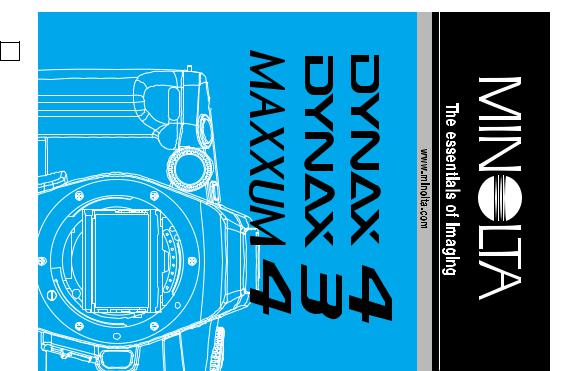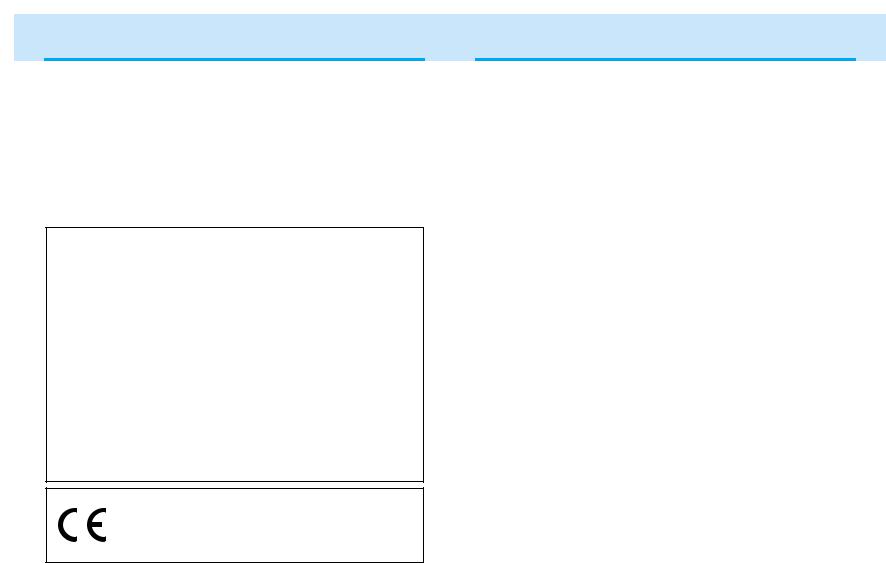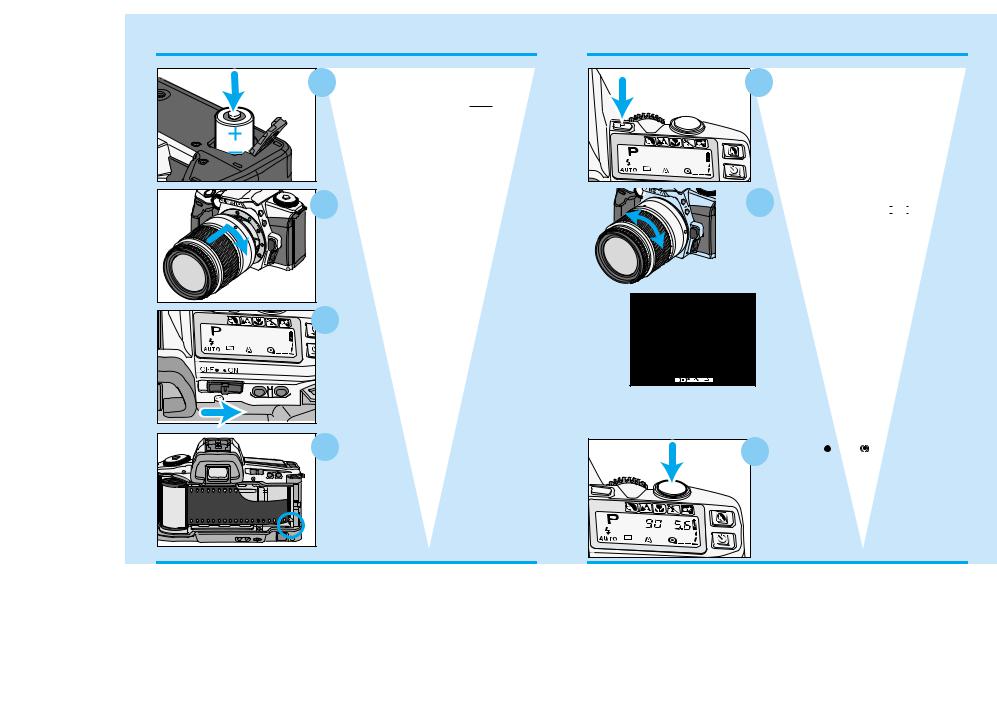Minolta MAXXUM 4, Dynax 4, Dynax 3 User guide

<![endif]>MANUAL INSTRUCTION E
APPENDIX |
|
CUSTOM |
|
DETAILED |
|
CREATIVE |
|
SUBJECT / |
|
AUTOMATIC |
|
GETTING |
|
FUNCTIONS |
|
OPERATION |
|
EXPOSURE |
|
DRIVE |
|
OPERATION |
|
STARTED |
|
|
|
|
|
|
|
|
||||||
|
|
|
|
|
|
|
|
|
|
|
|
|

TABLE OF CONTENTS
The GETTING STARTED section describes how to prepare the camera for use. The FULLY-AUTOMATIC OPERATION chapter shows how to take photographs quickly and simply by using the camera’s automatic features. Advanced shooting features are covered in SUBJECT PROGRAM / DRIVE MODES. The CREATIVE EXPOSURE MODE section introduces exposure control. The DETAILED OPERATION section describes advanced functions within the camera. The last section, CUSTOM FUNCTIONS, shows how to customize camera operation. Custom Function Notes have been inserted throughout the manual as reference to camera operations that can be changed.
|
FOR PROPER AND SAFE USE ........................................ |
7 |
|
QUICK OPERATION ........................................................ |
10 |
|
NAMES OF PARTS .......................................................... |
12 |
|
Body ............................................................................ |
12 |
|
Data Panel .................................................................. |
14 |
|
Viewfinder.................................................................... |
15 |
|
GETTING STARTED |
|
|
STRAP ............................................................................ |
17 |
|
Attaching the Strap .................................................... |
17 |
| <![if ! IE]> <![endif]>STARTED |
Changing the Batteries - Quarz-date model .............. |
21 |
|
Using the Eyepiece Cap ............................................ |
18 |
|
BATTERIES .................................................................... |
19 |
|
Installing the Batteries ................................................ |
19 |
|
Battery Condition Indicators........................................ |
20 |
|
LENS................................................................................ |
22 |
| <![if ! IE]> <![endif]>GETTING |
Loading the Film ........................................................ |
23 |
|
Attaching the Lens ...................................................... |
22 |
|
Removing the Lens .................................................... |
22 |
|
FILM ................................................................................ |
23 |
|
Film Chamber Lock .................................................... |
25 |
|
Rewinding the Film .................................................... |
26 |
|
Manual Rewind .......................................................... |
26 |
2
<![endif]>AUTOMATIC OPERATION
<![if ! IE]><![endif]>SUBJECT / DRIVE
FULLY-AUTOMATIC OPERATION |
|
HANDLING THE CAMERA ............................................ |
28 |
Pressing the Shutter-release Button .......................... |
28 |
Holding the Camera .................................................... |
28 |
AUDIO SIGNAL .............................................................. |
29 |
TAKING PICTURES IN FULL-AUTO .............................. |
30 |
FOCUS ............................................................................ |
32 |
Focus Signals.............................................................. |
32 |
Special Focus Situations ............................................ |
33 |
FOCUS LOCK ................................................................ |
34 |
USING THE BUILT-IN FLASH ........................................ |
35 |
Flash Signals .............................................................. |
35 |
Flash Range................................................................ |
36 |
Lens Shadowing.......................................................... |
36 |
Fill Flash ...................................................................... |
37 |
Flash Cancel .............................................................. |
37 |
Red-eye Reduction .................................................... |
38 |
SUBJECT PROGRAM / DRIVE MODES |
|
SUBJECT PROGRAM SELECTION .............................. |
40 |
Portrait ........................................................................ |
40 |
Landscape .................................................................. |
41 |
Close-up...................................................................... |
42 |
Sports.......................................................................... |
43 |
Night Portrait .............................................................. |
44 |
Photographing Night Scenes ...................................... |
45 |
DRIVE MODES ................................................................ |
46 |
Self-timer .................................................................... |
46 |
Continuous Advance .................................................. |
48 |
For Owners of the Remote-control Function .............. |
49 |
Focus Lock in Remote Control Mode ........................ |
50 |
continued on next page |
|
| <![if ! IE]> <![endif]>GETTING |
<![if ! IE]> <![endif]>STARTED |
|
|
|
|
| <![if ! IE]> <![endif]>AUTOMATIC |
<![if ! IE]> <![endif]>OPERATION |
|
|
|
|
| <![if ! IE]> <![endif]>SUBJECT / |
<![if ! IE]> <![endif]>DRIVE |
|
|
|
|
| <![if ! IE]> <![endif]>CREATIVE |
<![if ! IE]> <![endif]>EXPOSURE |
|
|
|
|
| <![if ! IE]> <![endif]>DETAILED |
<![if ! IE]> <![endif]>OPERATION |
|
|
|
|
| <![if ! IE]> <![endif]>CUSTOM |
<![if ! IE]> <![endif]>FUNCTIONS |
|
|
|
<![if ! IE]> <![endif]>APPENDIX |
3

TABLE OF CONTENTS |
|
|
|
CREATIVE EXPOSURE MODES |
|
|
APERTURE CONTROL .................................................. |
52 |
| <![if ! IE]> <![endif]>EXPOSURE |
|
|
|
SHUTTER CONTROL .................................................... |
53 |
|
EXPOSURE MODES ...................................................... |
54 |
|
A MODE (APERTURE PRIORITY) ................................ |
55 |
|
Flash With A Mode ...................................................... |
57 |
|
S MODE (SHUTTER PRIORITY) .................................... |
58 |
|
Flash With S Mode...................................................... |
59 |
| <![if ! IE]> <![endif]>CREATIVE |
|
|
|
M MODE (MANUAL) ...................................................... |
60 |
|
Metring in Manual Mode ............................................ |
61 |
|
Flash With M Mode .................................................... |
62 |
|
P MODE ............................................................................ |
63 |
|
PA mode...................................................................... |
63 |
|
Ps mode ...................................................................... |
64 |
|
EXPOSURE WARNINGS ................................................ |
65 |
|
DETAILED OPERATION |
|
|
FOCUS AREA ................................................................ |
67 |
|
Wide Focus Area ........................................................ |
67 |
|
Spot Focus Area ........................................................ |
68 |
|
Local Focus Areas ...................................................... |
69 |
| <![if ! IE]> <![endif]>OPERATION |
|
|
|
Focus Area Selection controls .................................... |
70 |
|
FOCUS MODES.......................................................... |
71 |
|
Automatic AF .............................................................. |
71 |
|
Continuous AF .......................................................... |
72 |
|
Single-shot AF ............................................................ |
73 |
|
Manual Focus.............................................................. |
74 |
|
AF ILLUMINATOR .......................................................... |
75 |
| <![if ! IE]> <![endif]>DETAILED |
|
|
|
EXPOSURE .................................................................... |
76 |
|
14-Segment Honeycomb Pattern Metering ................ |
76 |
|
Spot Metering.............................................................. |
76 |
|
Spot-AE Lock .............................................................. |
77 |
|
TAKING TIME EXPOSURES (buLb) .............................. |
79 |
|
EXPOSURE COMPENSATION ...................................... |
82 |
|
Checking Exposure Compensation ............................ |
83 |
<![endif]>DETAILED OPERATION
| <![if ! IE]> <![endif]>CUSTOM |
<![if ! IE]> <![endif]>FUNCTIONS |
|
|
|
|
| <![if ! IE]> <![endif]>APPENDIX |
|
|
|
SETTING THE ISO MANUALLY .................................... |
84 |
EXPOSURE BRACKETING ............................................ |
85 |
Continuous Advance Bracketing ................................ |
86 |
Single Frame Advance Bracketing.............................. |
86 |
Flash Notes ................................................................ |
87 |
Bracketing with the Exposure-compensation Button .. |
87 |
MULTIPLE EXPOSURE .................................................. |
88 |
Metering Multiple Exposure ........................................ |
90 |
FLASH ............................................................................ |
91 |
Program Flash ............................................................ |
91 |
Attaching the Program Flash ...................................... |
92 |
Flash Metering ............................................................ |
92 |
SLOW-SYNC .................................................................. |
94 |
WIRELESS/REMOTE FLASH ........................................ |
95 |
Setting Wireless/Remote Flash Mode ........................ |
96 |
Taking Pictures in Wireless/Remote Flash Mode ...... |
97 |
FOR OWNER’S OF THE QUARTZ DATE MODEL ...... |
100 |
Setting the Date or Time .......................................... |
100 |
Imprinting the Date or Time ...................................... |
101 |
Changing the Date Format........................................ |
102 |
CUSTOM FUNCTIONS.................................................... |
103 |
APPENDIX.......................................................................... |
112 |
PROGRAM-RESET BUTTON ...................................... |
113 |
ACCESSORY INFORMATION ...................................... |
114 |
TROUBLE SHOOTING.................................................. |
118 |
CARE AND STORE ...................................................... |
120 |
SPECIFICATIONS ........................................................ |
122 |
INDEX ............................................................................ |
124 |
MEMO............................................................................ |
126 |
| <![if ! IE]> <![endif]>GETTING |
<![if ! IE]> <![endif]>STARTED |
|
|
|
|
| <![if ! IE]> <![endif]>AUTOMATIC |
<![if ! IE]> <![endif]>OPERATION |
|
|
|
|
| <![if ! IE]> <![endif]>SUBJECT / |
<![if ! IE]> <![endif]>DRIVE |
|
|
|
|
| <![if ! IE]> <![endif]>CREATIVE |
<![if ! IE]> <![endif]>EXPOSURE |
|
|
|
|
| <![if ! IE]> <![endif]>DETAILED |
<![if ! IE]> <![endif]>OPERATION |
|
|
|
|
| <![if ! IE]> <![endif]>CUSTOM |
<![if ! IE]> <![endif]>FUNCTIONS |
|
|
|
<![if ! IE]> <![endif]>APPENDIX |
4 |
5 |

Thank you for purchasing this camera. Please take time to read this manual so that you can enjoy all the features of your new camera. This manual has been designed to help you understand the camera’s operation quickly. The information in this manual is relevant for products introduced before May, 2002. Contact the nearest authorized Minolta Service facility to obtain compatibility information for products released after this date.
This camera is designed to work specifically with lenses and accessories manufactured and distributed by Minolta. Using incompatible accessories with this camera may result in unsatisfactory performance or damage the camera and accessories.
This device complies with Part 15 of the FCC Rules. Operation is subject to the following two conditions: (1) This device may not cause harmful interference, and (2) this device must accept any interference received, including interference that may cause undesired operation. Changes or modifications not approved by the party responsible for compliance could void the user's authority to operate the equipment. This equipment has been tested and found to comply with the limits for a Class B digital device, pursuant to Part 15 of the FCC Rules. These limits are designed to provide reasonable protection against harmful interference in a residential installation. This equipment generates, uses and can radiate radio frequency energy and, if not installed and used in accordance with the instructions, may cause harmful interference to radio communications. However, there is no guarantee that interference will not occur in a particular installation. If this equipment does cause harmful interference to radio or television reception, which can be determined by turning the equipment off and on, the user is encouraged to try to correct the interference by one or more of the following measures:
•Reorient or relocate the receiving antenna.
•Increase the separation between the equipment and the receiver.
•Connect the equipment to an outlet on a circuit different from that to which the receiver is connected.
•Consult the dealer or an experienced radio/TV technician for help.
This Class B digital apparatus complies with Canadian ICES-003.
This mark on the bottom of your camera is there to inform you that this camera meets the requirements of the EU (European Union) concerning interference causing equipment regulations. CE stands for Conformité Européenne (European Conformity).
FOR PROPER AND SAFE USE
Read and understand all warnings and cautions before using this product.
 WARNING
WARNING
Using batteries improperly can cause them to leak harmful solutions, overheat, or explode which may damage property or cause personal injury. Do not ignore the following warnings.
•Only use the batteries specified in this instruction manual.
•Do not install the batteries with the polarity (+/–) reversed.
•Do not use batteries which show wear or damage.
•Do not expose batteries to fire, high temperatures, water, or moisture.
•Do not attempt to short or disassemble batteries.
•Do not store batteries near or in metallic products.
•Do not mix batteries of different types, brands, or ages.
•Do not use leaking batteries. If fluid from the batteries enters your eye, immediately rinse the eye with plenty of fresh water and contact a doctor. If fluid from the batteries makes contact with your skin or clothing, wash the area thoroughly with water.
•Tape over lithium battery contacts to avoid short-circuiting during disposal; always follow local regulations for battery disposal.
•Do not disassemble this product. Electric shock may cause injury if a high voltage circuit inside the product is touched. Take the product to a Minolta Service Facility when repairs are required.
6 |
7 |

FOR PROPER AND SAFE USE
 WARNING
WARNING
•Immediately remove the batteries and discontinue use if the camera is dropped or subjected to an impact in which the interior, especially the flash unit, is exposed. The flash has a high voltage circuit which may cause an electric shock resulting in injury. The continued use of a damaged product or part may cause injuries.
•Keep batteries or small parts that could be swallowed away from infants. Contact a doctor immediately if an object is swallowed.
•Store this product out of reach of children. Be careful when around children, not to harm them with the product or parts.
•Do not fire the flash directly into the eyes. It may damage eyesight.
•Do not fire the flash at vehicle operators. It may cause a distraction or temporary blindness which may lead to an accident.
•Do not look at the sun or strong light sources directly through the viewfinder or lens. It may damage your eyesight or cause blindness.
•Do not expose this product to liquids or operate this product with wet hands. If liquid enters the product, immediately remove the batteries and discontinue use. The continued use of a product exposed to liquids may cause damage or injury through fire or electric shock.
•Do not use the product near inflammable gases or liquids such as gasoline, benzine, or paint thinner. Do not use inflammable products such as alcohol, benzine, or paint thinner to clean the product. The use of inflammable cleaners and solvents may cause an explosion or fire.
•If the product emits a strange odor, heat, or smoke, discontinue use. Immediately remove the batteries taking care not to burn yourself. The continued use of a damaged product or part may cause injuries.
•Take the product to a Minolta Service Facility when repairs are required.
 CAUTION
CAUTION
•Do not point the product directly at the sun. If sunlight is focused on an inflammable surface, a fire may result. Replace the lens cap when the product is not in use.
•Do not use or store the product in a hot or humid environment such as the glove compartment or trunk of a car. It may damage the product and batteries which may result in burns or injuries caused by heat, fire, explosion, or leaking battery fluid.
•If batteries are leaking, discontinue use of the product.
•Do not fire the flash while it is in contact with people or objects. The flash unit discharges a large amount of energy which may cause burns.
•Do not apply pressure to the data panel. A damaged panel may cause injury, and the liquid from the panel may cause inflammation. If liquid from the panel makes contact with skin wash the area with fresh water. If liquid from the panel comes in contact with the eyes, immediately rinse the eyes with plenty of water and contact a doctor.
8 |
9 |

QUICK OPERATION
1 |
2 |
|
lens with the one on the camera. |
|
Carefully insert the lens into the mount |
|
and turn it clockwise until it clicks into |
|
the locked position. |
p.22 |
3 Slide the main switch to ON. |
|
4 |
Load the film. |
• Align the film tip with the red mark, |
|
|
then close the back cover. |
|
p.23 |
10 |
|
Set full-auto operation.
•Press the program-reset button to set the camera to fully automatic operation. p.30
|
|
6 |
Center your subject in the |
||||
|
|
wide focus frame |
|
|
. If using |
||
|
|
||||||
|
|
|
|
a zoom lens, rotate the |
|||
|
|
|
|
zooming ring to frame your |
|||
|
|
|
|
subject as desired. |
|
|
|
|
|
|
|
The camera will focus and set |
|||
|
|
|
|
exposure automatically when the |
|||
|
|
|
|
shutter release button is pressed |
|||
|
|
|
|
||||
|
|
|
|
partway down. |
p.28 |
||
The audio signal confirms the camera has focused when the shutter release button is pressed partway down.
p.29
7 |
When |
or |
appears in the |
|
viewfinder, press the shutter- |
||
|
release button all the way |
||
|
down to take the picture. |
||
|
• Use focus lock if your subject is off- |
||
|
center and outside the focus frame. |
||
|
|
|
p.32 |
11
